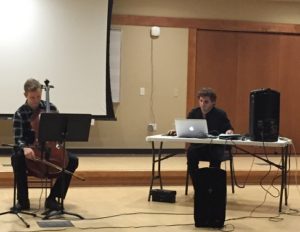David Mason, Daniel McNamara in Concert
 Searching for Serotonin, the west coast tour by cellist David Mason and sound projectionist Daniel McNamara, landed at the Ventura College Performing Arts Center on Wednesday, November 15, 2017. Four works of experimental new music were presented including pieces by Kaija Saariaho and György Ligeti. A midweek crowd of the knowledgeable and the curious gathered to hear a combination of acoustic cello and electronics as presented by Mason and McNamara.
Searching for Serotonin, the west coast tour by cellist David Mason and sound projectionist Daniel McNamara, landed at the Ventura College Performing Arts Center on Wednesday, November 15, 2017. Four works of experimental new music were presented including pieces by Kaija Saariaho and György Ligeti. A midweek crowd of the knowledgeable and the curious gathered to hear a combination of acoustic cello and electronics as presented by Mason and McNamara.
The concert began with Sonata for Solo Cello, by György Ligeti. This was written between 1948 and 1953 at the height of Stalin’s power in Soviet Russia, and consists of two movements. The first, “Dialogo”, opened with soft pizzicato arpeggios, a low, solemn tone – and then silence. More arco playing followed, darkly expressive in the lower registers and at times pleasingly lyrical in the higher. The second movement, “Capriccio”, was much faster and more animated. Agitated runs upward built tension, even as the passages downward lessened the anxiety, see-sawing back and forth. Some double-stopped phrasing in the lowest registers produced a menacing growl while in other places the feeling was more conventionally purposeful and open. Ligeti wrote of this piece: “I was 30 years old when I wrote it. I loved virtuosity and took the playing to the edge of virtuosity much like Paganini.” Mason was in complete command as he moved confidently among the passages as they furiously unfolded at the finish.
A recorded augmentation followed, created by McNamara, and this was an electronically processed version of Sonata for Solo Cello as heard through two large speakers on stage. The cello was tacit during this and the augmentation included reverb, echoing, panning and some additional power, especially in the lower tones. There was a 3D effect to this, as well as a sense of remoteness as the processing gradually became more intense. Both movements were heard and the enhancements added an interesting element of strength to the character of the original piece. Sonata for Solo Cello nicely combined the abilities of Mason’s acoustical cello technique with McNamara’s electronic augmentation.
Tide, by Matt Sargent followed, a composition for layers of strings and solo cello. In this piece the electronics assumed the primary role by way of a set of pre-recorded cello tones by T.J. Borden. The opening sounds coming through the speakers were forceful and intense, eventually reaching a total of ten layers. The booming in the lower registers was felt as much as heard, an elemental force of nature like a rising sea or surging tide. The direction of the pitch changes in the recording was indicated on McNamara’s computer screen, positioned so that Mason could see it. As the tones in the recording rose or fell, Mason adjusted his acoustical playing to fit into the new harmony. The changes proceeded slowly and deliberately; the overall effect was like being inside some giant machine that was gradually accelerating or decelerating. The great wash of sounds embraced the listener with a series of continually shifting surfaces that were never tiresome or monotonous. Tide is a beautiful and engagingly simple piece that intimately connects the electronics, performer and audience in a powerfully organic experience.
After a short intermission, the concert continued with Petals, by Kaija Saariaho, who describes her piece this way: “The opposite elements here are fragile coloristic passages which give birth to more energetic events with clear rhythmic and melodic character… In bringing together these very opposite modes of expressions, I aimed to force the interpreter to stretch his sensibility.” Accordingly, Petals opens with light and airy trills in the cello and softly scratching sounds from the electronics. These start high then go lower in pitch, becoming rapidly louder like an angry bee, and devolving into a series of very complex passages before returning to the quiet trills of the beginning. Clear, declarative phrasing is heard, very expressively played by Mason, followed by a softer section featuring single, quietly sustained tones. This subdued texture becomes a bit busier, and then suddenly louder, with trills and more complexity building up the tension before the piece coasts to its finish. The extremes in character and dynamics present in Petals present an impressive technical challenge to the player and an invigorating experience for the audience.
The final piece in the concert was Oog, by Dutch composer Michael van der Aa. This piece includes a pre-recorded sound track that requires the cello player to use a stopwatch to make the closely timed entrances. Oog, which means eye in Dutch, begins with a slow, sustained tone that quickly breaks into a rapid series of phrases involving extended techniques such as rapping on the wooden cello body. More sustained notes follow, quietly and sensitively played, while the electronics inexorably build until a great explosion of sound is heard. The piece now becomes very complex – chaotic even – with rapid cello phrases carefully woven in and around the equally intricate electronics. The close coordination between the recording and Mason’s playing was impressively precise. The fast cello runs and loud, percussive blasts from the speakers had an unsettling, out-of-control feeling that was both stimulating and alarming. Towards the finish the softer tones returned, and a slower, solemn sensibility asserted itself as the piece concluded. Oog is a formidable combination of speed and split-second timing that requires the sort of alert technical virtuosity that was unmistakably present in this performance.
The Searching for Serotonin tour concludes at 8 PM on Tuesday, November 21 at Gray Studios in North Hollywood.